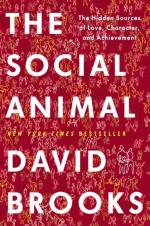
|
| Name: _________________________ | Period: ___________________ |
This test consists of 15 multiple choice questions and 5 short answer questions.
Multiple Choice Questions
1. How does Brooks describe Harold's intelligence in Chapter 6?
(a) Enigmatic.
(b) Average.
(c) Excellent.
(d) Deficient.
2. How many children do Brooks' wealthy socialites all have in Chapter 1?
(a) None.
(b) One.
(c) Three.
(d) Two.
3. What famous intellect does Brooks mention at the end of his introduction?
(a) Vidal.
(b) Hawking.
(c) Hofstadter.
(d) Hume.
4. According to Brooks at the beginning of Chapter 1, what large accessory do his social ascendants always have?
(a) A huge television.
(b) A huge dog.
(c) A huge unvarnished dining table.
(d) A huge pool.
5. What is the term that Antonio Damasio coins?
(a) Emotional Pulse Directive.
(b) Emotional Acuity Index.
(c) Emotional Sensitivity Response.
(d) Emotional Positioning System.
6. What separates us from animals, according to Brooks in the introduction?
(a) Our ability to rationalize.
(b) Our ability to use language.
(c) Our ability to use tools.
(d) Our ability to form social bonds.
7. In the beginning of Chapter 5, to what does Brooks compare Harold's writing on his worksheet?
(a) Sanskrit.
(b) Typesetting.
(c) Morse code.
(d) A Jackson Pollock.
8. In Chapter 4, Harold illustrates his ability to abstract by saying he is what?
(a) A giant.
(b) A tiger.
(c) A cloud.
(d) An airplane.
9. In the introduction, Brooks states that Harold and Erica have what type of skills?
(a) Rational skills.
(b) Paranormal skills.
(c) Arithmetic skills.
(d) Noncognitive skills.
10. In Chapter 3, what does Brooks show that neurons do when we are near someone we are bonded to socially?
(a) Pulse at regular intervals.
(b) Stay dormant.
(c) Mirror the other person's neurons.
(d) Charge at faster rates.
11. In Chapter 4, what is Harold's favorite pastimes besides bonding with Julia?
(a) Pulling things off tables.
(b) Sleeping.
(c) Bonding with Rob.
(d) Riding the dog.
12. Which Greek figure does Harold compare himself to in his journal when discussing anger?
(a) Menelaus.
(b) Hector.
(c) Agamemnon.
(d) Achilles.
13. Whose parents are Rob and Julia?
(a) Harold.
(b) David Brooks.
(c) Hostadter.
(d) Erica.
14. What rare ability does Harold have in high school society?
(a) He can get A's without studying.
(b) He can laugh at an insult.
(c) He can speak to girls.
(d) He can mirror cliques.
15. What does Ms. Taylor want to match each student to?
(a) A life goal.
(b) A book.
(c) A perfect song.
(d) A lover.
Short Answer Questions
1. Whose method does Brooks acknowledge he is borrowing in the introduction?
2. What does Brooks say both Julia and Rob worry about doing when they meet?
3. After Rob and Luis get married in Chapter 1, what task does Rob always insist on handling?
4. What do children lack at an early age?
5. Which of the following ridiculous items is listed in the homework requirements in Chapter 5?
|
This section contains 444 words (approx. 2 pages at 300 words per page) |

|




